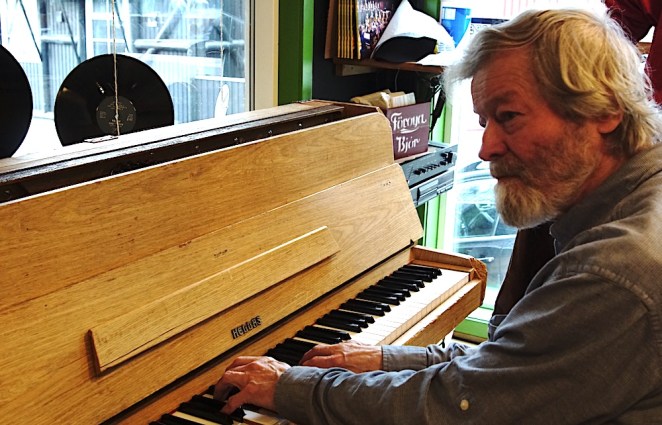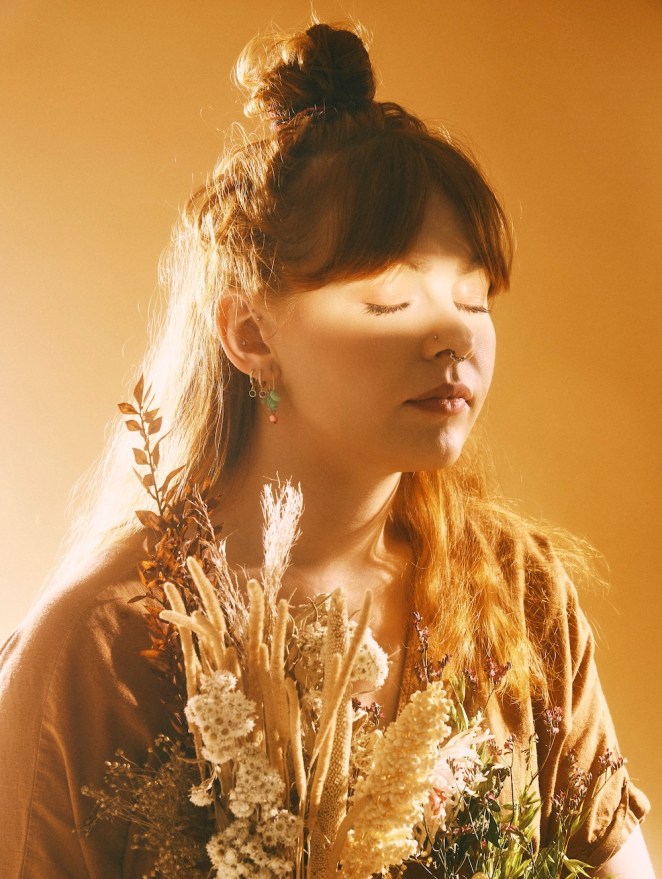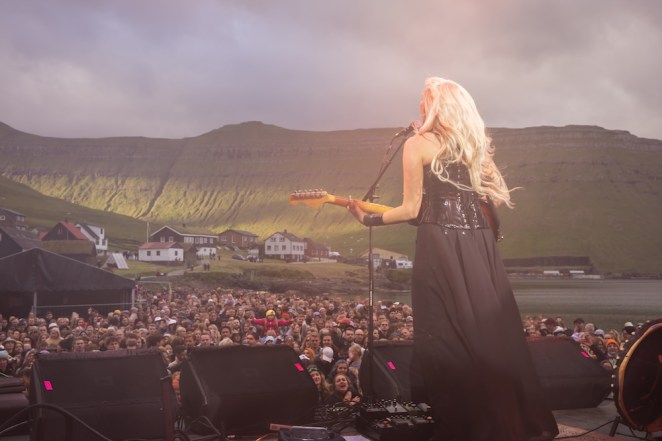“It’s strange to think that recorded music is roughly 100 years old, and we’ve been involved in it half of the time,” says Kristian Blak. Sitting in front of his piano on the ground floor of the record shop Tutl, also the namesake of the label he founded in the Faroe Islands capital of Tórshavn in 1979, the Danish musician, composer, and producer is aware that the region, a self-governing territory under Denmark, is behind most countries in recording, but it has made up for the lost time.
For nearly 50 years, Blak and Tutl, which means a whisper or murmur in Faroese, has become the largest producer of new music across the Faroe Islands, distributing native folk, jazz, classical, hard rock, punk, hip-hop, within its catalog spanning nearly every genre. Even if the Faroe Islands, an 18-island archipelago nestled in the North Atlantic between Norway and Iceland, had a late start with documenting its history of recorded music, it has compensated for it with its diversity of artists on the label and a thriving music scene.
Embedded in a DIY ethos, Tutl still manages to operate like the earlier days in the recording industry when someone like Johnny Cash could walk into Sun Records in Memphis, Tennessee to audition, hoping to get signed. In the Faroe Islands, with a population of more than 53,400 (as of January 2024) with 22,000 of its inhabitants, alone, residing in Tórshavn, the music “business” has a wider welcome mat, opening its doors to most artists looking to get signed, some who walk into Tutl with a CD or USB of their work.
“You can criticize and say that we release anything, but what gets the attention is the group or the composer that has something special,” says Blak, who has also advised young artists who have come to the label throughout the years. “We could say ‘No’ for moral, political—whatever reason—but not musically.”
Videos by American Songwriter

When it started by happenstance, Tutl was a direct product of Blak’s Havnar Jazzfelag jazz club, which he opened in 1975 and his folk group Spælimenninir í Hoydølum. By 1977, Blak, born in the Jutland peninsula of Denmark in 1947 and moved to the Faroe Islands in ’74, found himself recording jazz music and had nearly 10 LPs within a year and a half. Throughout his 50-year career, Blak has composed everything from jazz and folk to instrumental, chamber, and symphonic music. Along with his solo material and a series of children’s music, he also serves as the artistic director of the annual Summartónar festival, showcasing classical composers.
“At that time, there were plenty of people, not labels, taking care of the ethnic and local pop music,” says Blak of the early days of Tutl. “[Some early recordings] started 20 years earlier, which is still late because other countries had labels since the ’20s. Even Iceland started [recording] 100 years before.”
Owned by the musicians and composers and supported by the state, today Tutl has approximately 1,100 listings within its catalog, a collection of eclectic artists, performing in Faroese and English, including rapper Marius DC, who released his EP MZA in 2019 at the age of 16, indie-pop artist Guðrið Hansdóttir, R&B-soul singer and songwriter Jazzygold, punk band 200, and an expanding line of new artists germinating from the Islands.
Distribution has also been critical to what Blak calls a “steady growth” of Tutl throughout the past 25 years. With some of its highest distribution in Denmark, Germany, and Eastern Europe, Tutl has also had a long relationship in the U.S. with the New York City-based distributor The Orchard for several decades, along with the Hamburg-based consulting agency Factory 92, which promotes and represents music from Nordic countries.
“It also depends on the artist,” says Glenn Larsen, director of Faroe Music Export and artists manager. “I think people don’t see Faroese music as a genre, so you can’t say where Faroe music is played. For example, the metal bands are bigger in Germany.”
Flipping through the Tutl catalog and deciphering any particular “Faroe sound” is difficult. Majestically set around looming mountains and fjords, incised by rocky gorges and streams, and pyramid-like stacked rock formations throughout the islands—remnants of years of volcanic activity and erosion like Risin og Kellingin (The Giant and the Witch) two sea stacks off the northern coast of the island of Eysturoy, named after one of the mythical legends of a giant and a witch who wanted to move the mountain to Iceland—there’s something in the landscape of the Faroes that feeds into its sounds.

All its folklore, moody and misty crevices, irregular terra firma, and expanse of nature—dotted with sheep, which outnumber the people on the Islands (at roughly 75,000)—is something tour guide and Faroe Islands native, Elin Hentze believes is part of the essence of Faroese music. For Hentze, the music from the Islands comes from a “force of nature” and a sense of “presence” in the natural setting of the Faroes.
“I can hear the wind, the storm in their voices,” she says. “It’s so calm, present. You can hear the presence in the mountains. You have to be present. You can’t be anywhere else, and the influence is everywhere.” Hentze adds, “I think we are still rooted in our old culture as well as being a new country. We are very proud. You have to know yourself. Otherwise, you lose yourself.”
Still, there’s no specific “sound” within the breadth of Faroese music, which only adds to the allure of artists under Tutl. Contemporary Faroe artists like Eivør, considered one of the biggest artists to come out of the Islands, crossed multiple genres, recording traditional Faroese folk music, harder rock, pop, jazz, electronic, and more.
For Eivør and other artists, touring internationally has also been a significant marker in expanding the reach of Faroe music, in addition to performing locally, and keeping the music scene, predominantly in Tórshavn, healthy.

Transitioning from the new classical music in the ‘80s, Tutl began steadily growing in the 1990s, sparked by an incision of more bands emerging, along with artists making music in English as well as Faroese. Since then, responsibilities within the label and record shop have been divided collectively.
“I used to do everything,” says Blak, now 77, who shares duties with Faroese-American soul-pop artist Marianna Winter and Fríði Djurhuus, vocalist for the queer punk band Joe & the Sh–boys, just two Tutl artists working at the shop. “The more success with all the bands, the more work there was [but since] 25 years ago, we have had people working in the shop. Some days, we have no [record] shop open. We don’t earn enough money to have five full-time jobs, which we would like to have. We have one that five people share.”
Also employed at Tutl is Dania O. Tausen, who won the 2024 Faroe Music Award for Best Album for her 2023 release ja/nei (yes/no) and first came to the label in 2019. “I just walked in and asked if I could work at the shop,” says Tausen, who debuted her book of poetry Skál (Cheers) and a documentary of the same in 2020 and her debut Gonguteigatúnato (Crosswalktalks) a year later. “I found out that it was more of a label, and I was releasing my first music at the time and very interested in how it works.”
A majority of Tutl artists have also made their way to the annual G! Festival, held in the seaside village of Syðrugøta (also called Gøta) over three days during the summer. Since launching in 2002, when festival director Sigvør Laksá’s daughter and some friends had a one-day event featuring 10 artists—nine from the Faroes and one Bulgarian band who were in town—the G! Festival now welcomes 5,000 attendees annually, including 500 from abroad. The latter number Laksá, also the longtime manager of Eivør, prefers not to stretch any further to keep the integrity of the festival.
“We don’t want more than that, because then you can’t speak Faroese because every second person is responding in English or something,” says Laska. “We want it to feel like a Faroese experience.”

Set along the beach with three stages, the festival has also leveled at a 50-50 split of Faroese artists and international acts. Icelandic indie rockers Of Monsters and Men and punk trio GRÓA, British artist Jamie Grey and The Longest John from the UK, rapper Ash Olsen, and Das Body from Norway, Swedish singer and songwriter Alice Boman, Greenland death metal band Sound of the Damned, and more are part of the 2024 lineup, along with Faroe artists like Tausen, who will be performing solo and with her group, the avant-punk and hip-hop AGGRASOPPAR, Elinborg (younger sister of Eivør), Teitur, Knút, Hamferd, and Alias Morera, among others.
To keep the native spirit of the festival, Laska also doesn’t want it to extend beyond its means or run longer than a weekend in the small village of around 560 residents, who open their doors to attendees and artists and allow them to live in their homes during the three-day festival since there are no hotels and just a few stores in the area. “You end up with someone that you don’t know at all,” says Laska. “You have to share their bath and the kitchen, and you eat with them but it works. Most people end up becoming friends, adds Laska, and stay in touch long after the festival.”
Running G! Festival for a week would be “far too much,” says Laska. “We have to control the traffic,” she adds. “When everyone leaves the village on Sunday [after the festival], we still have to face all the people that live here and they should be happy.”
Gøta is also home to the annual Hoyma, a series of 20 concerts by 10 artists, which are held inside the living rooms of 10 family homes.
“People are happy to live here,” says Laska. “In this village, there’s not a shop, not a cafe. There’s a printing company, an international architect with 12 [employees], and a hairdresser. That’s basically what is in the village.”

Keeping G! Festival smaller in scale also provides a more authentic Faroese experience. Local delicacies like locally-cured and dried Saltfish are offered to all attendees free on the Saturday during the festival with a majority of the additional food provided by a company out of Tórshavn that works with hotels and restaurants. During the festival weekend, villagers will often bake bread. provide towels to concertgoers, and volunteer additional goods or services for the fest.
“Most people are quite invested in the festival and take on different tasks,” says Høgni Lisberg (HOGNI), who has performed at G! Festival since its inception in 2002, including earlier in his career with the band Clickhaze, featuring Eivør and the G! fest co-founder Jón Tyril.
G! Festival is the perfect rendering of Faroe music and any preconceptions of its sound. It showcases the music of the Faroes far removed from classic ballads, dark and dramatic folk or metal, which has emerged from most Nordic countries, or something out of a Viking saga. It’s far more evolved than most people can imagine, and part of its rich tapestry is a result of the artistic freedom Faroese artists have to cross multiple genres.
“People change from album to album,” says the drummer who has played with multiple artists along with releasing several solo albums from his 2003 debut, Most Beautiful Things through Within a Man in 2020. The 2024 fest will be the first year Lisberg will not perform in some capacity after being appointed booker for the festival.
“You’re completely free to create what you want to create,” adds Lisberg. “The Faroese way allows artists to be free to move between different genres. It’s a Faroese thing to try different genres. No one wants to be put in a box—or one box at a time.”
Main photo: Eivør, Photo by Anne-Laure Amayon
